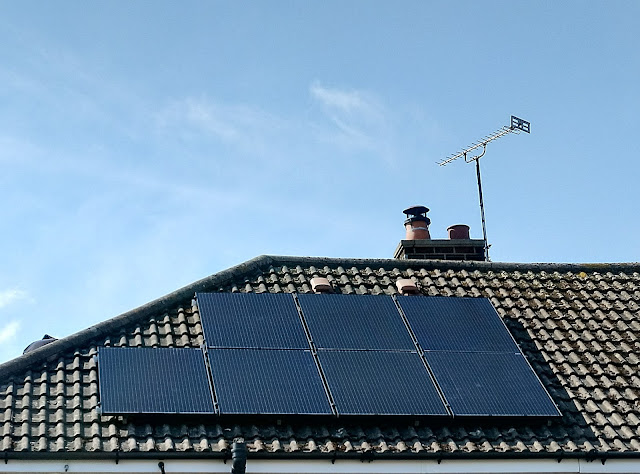The Generation Game.
Our solar panels have been in for a year now, so it's time for a quick review. The table below shows some figures for the year.
Some of these need a little explanation. For example why we both export and import electricity it is easily explained. Since the solar obviously does not generate after the sun goes down, but we still want to boil kettles and watch TV after dark, we still import electric. Similarly, there are days of bloody awful weather, and the short winter days in this part of the world, which all lead to consumption without much generation. Yet there are also good days where the amount we generate exceeds what we can consume.
The total consumption figure is made up of the total generated plus the electricity we imported from the grid, less the amount we exported. It is high because we are trying to use as much of the electric we generate as possible. We do this because of the extreme difference between the price we pay the electric company for electric and the price they pay us for each unit we export. Unfortunately the electric company are monopoly buyers, and they set their own buying price! While that sounds pretty crooked to me, it is the way it is, so we have to live with it. The difference between the sale and buying price is approximately 500%!
Worse yet, we already had a modern digital meter that was made for home solar installations. It shows both grid imports and exports. Since this was a new installation the export reading was zero, yet when the time came for Power NI to pay us for what we had exported, they ignored the first 270 units or so; I have no idea why, but their system sucks. When the panels were installed, we had to provide them with a picture of the meter readings. Then they also sent one of their engineers out to install exactly the same sort of meter that we already had, and which they originally installed. He didn't install anything, but took another picture of the readings which were higher by then. Somewhere in all this mess Power NI seem to have decided that the first lot of units that they didn't bother paying for had just magically appeared on our meter. It isn't worth arguing with them over because the amount of money involved is so pitifully small at their rubbish buying price anyway.
The main way that we are using up our own surplus generation is by heating our hot water tank. I have mentioned before that there is a sensor in the system that switches on our immersion heater when it detects that we are passing power to the grid. I estimate that this is the largest of the three methods by which we save money with this system.
The three are:-
1) Heating our water tank - We still have a gravity fed system running in two zones, one for the water tank and one for the radiators, which is powered by an oil boiler. Heating our water, and it gets seriously hot (around 60 degrees C on good days), means that in summer the boiler simply does not switch on, and in winter we use the hot water boost button much less often. If this system heats the water as well as the solar thermal one that it replaced (and it does seem to), then we probably save using around eight to nine hundred litres of oil per year. This is not just good for the planet, it's also good for my bank balance, especially given the current increases in the price of oil. This is undoubtedly the biggest impact of the system.
2) Generating our own daylight consumption. - a relatively small saving compared to the above, but useful none the less, especially since we are still home working.
3) Exporting to the grid. - There isn't much to say about this, except that if you were relying on the paltry amount that Power NI hand out, then no one would ever install solar panels on their houses in the first place.
Given the current oil price, the combined saving are probably around £1000 per year. That gives a payback period of around five years which is not bad, and of course we are doing our own little bit to reduce our carbon footprint.









A really interesting post Ian. A mate 4 doors down from us has a similar system plus storage battery. He also has an MG EV which he charges at home with solar energy. I'm in the procrastination stage, particularly with an EV. Might be a hybrid next time.
ReplyDeleteHi Geoff,
ReplyDeleteI can understand your reluctance to go for a fully battery powered car. I too struggle to understand how they make sense unless you only travel short distances. I wonder too why the manufacturers chose to make individually sized batteries for each vehicle! This can only make vehicles obsolete very quickly, and surely that goes against every green credential that they are supposed to represent? The cars that will get scrapped as a result of the exorbitant cost of a replacement battery will be otherwise in good condition, and the energy and waste created as a result is entirely avoidable.
There is one EV maker called NIO who use standard sized batteries. At least with them when the battery degrades and loses its storage capacity (as they do), replacement would be relatively simple.
Until Hydrogen cars come in, EV's are a bit of a waste of time I think.
Ian